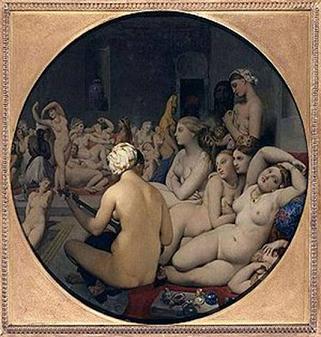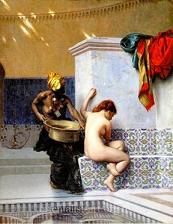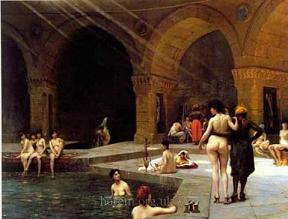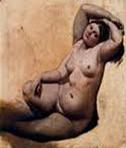ANALYZING INGRE DOMINIQUE’S ARTWORK:
LE BAIN TURC
Perspectives of art are diverse in nature. Among which some are classical and ancient yet still relevant today. One of such is Orientalism. Largely, this essay purposes to discuss the theory, as one of the modern and contemporary theories in art by critically analyzing form and content/subject matter of the Artwork “Le Bain Turc” .A systematic approach to this kind of discussion would firstly start by explaining the biographical background of the Artist. Furthermore, making effort to clarify what the concepts of form and content in Art are.
1.0 Orientalist theory
Orientalism is a nineteenth century European –Asian art which was purely decorative in nature. According to Edward Sayid, its long term images, stereotypes and general Ideology were all about the orient (Middle East) which is directly opposed to the western style also known as the oxidant.
Characteristically, orientalist art is accompanied by narratives about sensuality, cruelty i.e. the Asians being rated as cruel people, despotism, laziness, deceit, and irrationality of the Orientals. All in all it constitutes the negative “other” against which a positive Identity could be constructed (Ibid). Fact fully, Orientalism depends on the culturally constructed distinction between oxidant and orient rather than imaginative geography. Oriental style was extravagantly revived by John Nash (1752-1835) in his reconstruction of the Royal Pavilion in the English seaside resort of Brighton (Luigi Mayer).
Having defined what Orientalism is all about, it is important to also learn that Dominique Ingre was highly inspired and marked by the Orientalist Current even though he was purely a Neo-classic painter. According to internet sources, Ingre is reported to have been writing texts in his note book extolling about the baths of the seraglio of Mohammed in 1806, as well as copied Letters from the Orient by Lady Mary Montagu, who had accompanied her British diplomat husband to the Ottoman Empire in 1716 - her letters had been re-published eight times in France alone between 1763 and 1857, adding to the Orientalist craze there. The passage Ingres copied was entitled "Description of the women's bath at Adrianople" (Luigi Mayer’s internet commentary).
It was from after these influences then that Dominique Ingre in 1862 produced “Le Bain Turc”

“Le Bain Turc”
Oils on wood
Musée Louvre
108cm x 108 cm
2.0 Historical background
“The Turkish bath”, the English meaning of “Le Bain Turc” is an erotic painting done by Jean-Auguste-Dominique –Ingre when he was an 82 year old . Ingres was born in Montauban, Tarn-et-Garonne, France, the first of seven children (five of whom survived infancy) of Jean-Marie-Joseph Ingres (1755–1814) and his wife Anne Moulet (1758–1817) (Annette Labedzki’s summary).
"The Turkish Bath", a 43" X 43" wood panel painting in oil medium, is currently on display at the prestigious Louvre Museum in Paris. As the name connotes, this erotic piece of work is centred on a scene at one of the Turkish Baths, which fundamentally were hot water baths or sauna divided into various phases, where two or more persons would collectively take the bath ( Labedzki .A)![]() .
.
There are several reasons as to why “Le Bain Turc” why it is appropriate to critically analyzed from the perspective of the Orientalist art.


The Bathers
Gustave Clarence Rodolphe Boulanger “Turkish Bath” by Jean-Leon Gerome
Firstly, both the subject matter and the content originate from the orientalist inspiration. This is evident by the name itself, Turkey, a Middle Eastern oriental location. Second, is the form by which the artwork has been produced and painted. In order to analyze form in Ingres’s work, other orientalist artworks, purely from oriental museum will be used in comparison and reference to the fact that Ingre even though was Romantically and Neo-classically raised, he also did an orientalist work of art which can in no any other was be appreciated but with an orientalist approach. Other works like: “The Bathers”, by Gustave Clarence Rodolphe Boulanger, “Turkish bath” by Jean-Leon Gerome, and “The great Bath” by Jean-Leon again are some of the purely oriental works of Art.
 The great bath by Jean-Leon Gerome
The great bath by Jean-Leon Gerome
3.0 Subject Matter and content
Taking a closer look at “Ingres’s “Le Bain Turc”, it shows nude women in a harem . Originally rectangular, it was only converted to its present tondo form by the artist in 1863. One can see beautiful naked women in various poses... some conversing, others at their work, others drinking coffee or tasting a sorbet, and many stretched out nonchalantly, whilst their slaves (generally ravishing girls of 17 or 18 years) plaited their hair in fantastical shapes in the foreground. Ingre, also meticulously portrays the female nude in a passive and sexual context. On the ground there are as well exotic elements few and far between in the image – musical instruments, a censer and a few ornaments. (http://en.wikipedia.org/wiki/The_Turkish_Bath).
A critical viewer would analyze the scenario, by interpreting that slaves are being abused. Much more than that, there are black women slaves who are being used to entertain and amuse their mistresses. From Ingres’s painting (Le Bain Turk), the slaves can be seen far left in the foreground as well as the right hand side of the woman standing close to the wall. This is portrays a negative feeling of cruelty and racism which is typical of Orientals as earlier own stipulated. The idea of having black women slaves is highlighted in almost all the above mentioned artworks.
Equally important on the analysis of content and subject matter is the notion of despotism and laziness. While the mistresses are exercising their dictatorship (despotism) on the slaves, they are lazy to clean their own bodies. “The bath” by Jean-Leon critically shows how lazy the mistress poses in waiting for her clean up. On Ingre’ s work the same applies. Other women are folding their hands, others yawning, stretching, caressing and laughing.
Furthermore, “Le Bain Turn” and all other baths portrays the sensational environment of relax and sexuality which may be negative and provocative to others. This is typical of Orientalist art.
4.0 Form
Rationally, form stands for the shape, appearance, outline, structure, type, figure or variety of a thing while as Artistically, it technically stands for texture, line, shape (dimensions) colour, value, light effect, and size (mass or volume) of an Art work (thesaurus). From Ingres’s work, details are outlined with line such that one can tell the subject of depth, length and size of both the room and the people. However, Ingre is criticized for some proportional distortions of hands of the woman facing the direction of the viewers. They say the right shoulder does not qualify the lifted hand because the shoulder suits a rested arm (refer to artwork number 4). In terms of colour, Ingre as Neo-classicist polished and well blended the colours of the people’s skins but he does not fully achieve the brightness of an orientalist work.

(4)
Part of “Le Bain Turc”
In summary therefore, “Le Bain Turc” best fits as an oriental work of art unlike a Romanticist or Neo-classical one as others may be tempted to presume. There are a lot more things to learn from “Le Bain Turc” but the limitations of this essay would not accommodate all
Bibliography:
Gilbert R & McCarter W (1985), Living with Art, New York,
Paul Zelaski & Mary pat Fisher (1988) the art of seeing. London
Internet sources
Article Source: http://EzineArticles.com/?expert=Annette_Labedzki
R. G. Collingwood Form and Content in Art :JSTOR.org
http://en.wikipedia.org/wiki/Jean_Auguste_Dominique_Ingres
http://www.harem.org.uk/boulanger2.html (Harem baths)
http://www.all-art.org/history386.html (orientalism)
http://fr.wikipedia.org/wiki/Le_Bain_turc
Copyright © 2010 All rights reserved